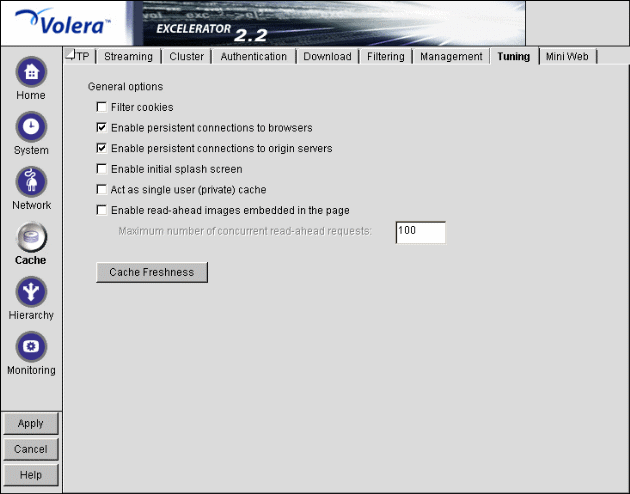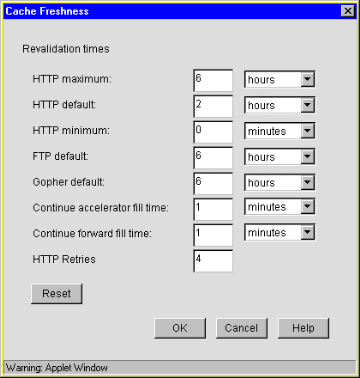
Figure 149 
The Tuning tab lets you restrict and enable functionality that affects all appliance operations. The implications for each option are explained below.
Filter Cookies: Excelerator removes all cookie HTTP request headers from requests forwarded to Web servers. It also removes all set-cookie HTTP reply headers from replies coming from Web servers.
Enable Persistent Connections to Browsers: All connections from browsers to the appliance remain open. This makes the response time between the appliance and browsers faster.
Enable Persistent Connections to Origin Servers: All connections from browsers to Web servers (through the appliance) remain open. This can cause some Web servers and their networks to crash, depending on the number of simultaneous connections they support.
Enable Initial Splash Screen: Browsers receive first-time and periodic notification that their requests are being processed by the appliance. The splash screen is customizable so that ISPs, for example, can advertise the fact that they are providing accelerated Web service. For information on customizing the splash screen, see Customizing the Appliance Splash Screen with FTP. The splash screen is disabled (turned off) by default.
Act as Single User (Private) Cache: Excelerator caches objects that have been flagged for private caches only.
Enable Read-Ahead Images Embedded in the Page: Excelerator retrieves and caches objects that have been flagged Read-Ahead. You specify the maximum number of Read-Ahead objects Excelerator will retrieve in the Maximum Number of Concurrent Read-Ahead Requests field.
Path: Cache > Tuning > Cache Freshness
Figure 150 
The Cache Freshness dialog box lets you set time values governing when Excelerator revalidates requested cached objects against those on their respective origin Web servers. If requested objects have changed, Excelerator re-caches them. Default field values are shown in Figure 150.
Excelerator does not automatically re-cache objects when they expire. Expired objects are revalidated (and re-cached if they have changed) only when requested by browsers and in accordance with the time values set in the Cache Freshness dialog box. For more information on the appliance's cache freshness features, see Cache Freshness.
HTTP Maximum: The maximum number of hours or days Excelerator will serve HTTP data from cache before revalidating it against content on the origin Web server. If an object has not been revalidated when this value expires, the object cannot be served from cache.
This overrides a freshness or Time to Expire header value specified by the Webmaster if he or she specified a longer time.
You can use this value to reduce the maximum time Excelerator waits before checking to see if requested objects need to be refreshed.
HTTP Default: The value Excelerator uses to determine when to revalidate requested objects for which Webmasters have not specified a freshness or Time to Expire header value.
HTTP Minimum: The minimum number of hours or minutes Excelerator will serve HTTP data from cache before revalidating it against content on the origin Web server. No requested object will be revalidated sooner than specified by this value.
This overrides the freshness or Time to Expire header value specified by the Webmaster if he or she specified a shorter time.
You can use this value to increase the minimum time Excelerator waits before checking to see if requested objects need to be refreshed. This parameter does not override No Cache or Must Revalidate directives from the origin Web server.
FTP Default: The number of hours or days FTP data remains in cache before it expires. Excelerator does not revalidate expired FTP objects. It simply re-caches them when they are requested.
Gopher Default: The number of hours or days Gopher data remains in cache before it expires. Excelerator does not revalidate expired Gopher objects. It simply re-caches them when they are requested.
Continue Accelerator Fill Time: The number of minutes or hours that the appliance's Web acceleration services ignore browser request cancellations and continue downloading objects from the target Web server until the download is complete.
Continue Forward Fill Time: The number of minutes or hours that the appliance's HTTP forward and transparent proxy services ignore browser request cancellations and continue downloading objects until the download is complete.
HTTP Retries: The number of retry requests that will be issued.